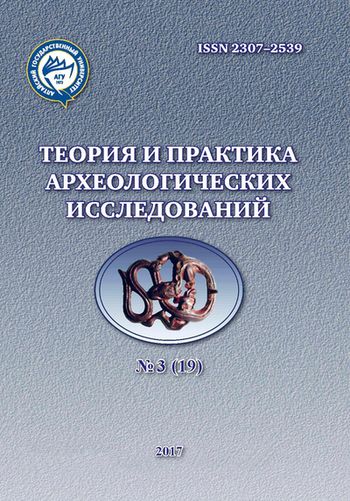REGARDING THE TYPOLOGY OF HILTS OF CHINESE EDGED WEAPONS - THE “PISTOL” GRIP AS THE DATING CHARACTERISTICS
Abstract
The most part of Chinese edged weapons traditionally have the hilt which is fixed by the riveting of the end of the tang on the end of the pommel. Some traditional hilts have wooden grips fixed to the tang with rivets. Practically all these hilts have the windings of textile cord or band. They are hilts traditional for China during thousands of years. However, as it is described in special literature, among Chinese edged weapons there are samples with so called “pistol” grips. These types are not traditional for China and could be used for the reliable dating characteristic for pieces of Chinese weapons in the museum and private collections. Judging by the material of the “pistol” grips - nephrite and wood - one is able to distinguish 2 types of handles dating by the 2nd half of 18th century and the 1sthalf of 19th century respectively. The 1st type could be connected reliably with the penetration of elements of Mughal military culture into the Qing Empire via Eastern Turkestan in the second half of the 18th century; the 2nd type could be connected presumably with the influence of the European naval edged weapons (beginning from Dutch and Portuguese ones) to the weapons of nations of South-East Asia and further - to the edged weapons of China. The extreme rarity of the hilts of the 2nd type demands the continuation of researches in this direction to find out the genesis of these hilts, the degree of popularity, the area and period of existing.
Downloads
Metrics
References
Anisimova M.A. Oruzhie Vostoka XV – pervoy poloviny KhKh veka: iz sobraniya Voenno-istoricheskogo muzeya artillerii, inzhenernykh voysk i voysk svyazi [Weapons of the East of the 15th – the first half of the 20th Century: from the Collection of the Military Historical Museum of Artillery, Engineer and Signal Corps]. SPb. : Atlant, 2013. 528 p. [In Russian]. Анисимова М.А. Оружие Востока XV - первой половины ХХ века: из собрания Военно-исторического музея артиллерии, инженерных войск и войск связи. СПб. : Атлант, 2013. 528 с.
Bichurin N.Ya. Opisanie Chzhun’garii i Vostochnogo Turkistana v drevnem i nyneshnem sostoyanii. Ch. II [Description of Zhonggar and East Turkistan in the Ancient and Current State. Part II]. SPb., 1829 [Electronic Resource] URL: http://www.vostlit.info/Texts/Dokumenty/China/Bicurin/Opis_Czungar_Vost_ Turkestan/text23.htm. [In Russian]. Бичурин Н.Я. Описание Чжуньгарии и Восточного Туркистана в древнем и нынешнем состоянии. Ч. II. СПб., 1829 [Электронный ресурс]. URL: http://www.vostlit.info/Texts/Dokumenty/China/ Bicurin/Opis_Czungar_Vost_Turkestan/text23.htm
Bichurin N.Ya. Pekinskoe dvortsovoe pravlenie [Peking Palace Rule]. Russkaya beseda. Sobranie sochineniy russkikh pisateley, izdavaemoe v pol’zu A.F. Smirdina [Russian Conversation. Collection of Works of Russian Writers, Published in Favor of A.F. Smirdin]. St. Petersburg, 1841. Vol. 2. Pp. 4–59 [Electronic Resource]. URL: http://www.vostlit.info/Texts/Dokumenty/China/Bicurin/Peking_dvorc_ pravl/text.htm. [In Russian]. Бичурин Н.Я. Пекинское дворцовое правление // Русская беседа. Собрание сочинений русских писателей, издаваемое в пользу А.Ф. Смирдина. СПб., 1841. Т. 2. С. 4-59. [Электронный ресурс]. URL: http://www. vostlit.info/Texts/Dokumenty/China/Bicurin/Peking_dvorc_pravl/text.htm
Bichurin N.Ya. Statisticheskoe opisanie Kitayskoy imperii (v dvukh chastyakh) [Statistical Description of the Chinese Empire (in two parts)]. M. : Vostochnyy dom, 2002. 464 p. [In Russian]. Бичурин Н.Я. Статистическое описание Китайской империи (в двух частях). М. : Восточный дом, 2002. 464 с.
Karlova E.M., Pastukhov A.M., Popov A.Yu., Uspenskaya E.N. Smertel’naya krasota. Oruzhie Indii i Kitaya. Katalog vystavki [Deadly Beauty. Weapons of India and China. Exhibition Catalog]. M. : Gosudarstvennyy Muzey Vostoka, 2015. 368 p. [In Russian]. Карлова Е.М., Пастухов А.М., Попов А.Ю., Успенская Е.Н. Смертельная красота. Оружие Индии и Китая. Каталог выставки. М. : Государственный Музей Востока, 2015. 368 с.
Mit’ko O.A., Kerzhaev A.M. Sablya iz Novoselovskogo rayona Krasnoyarskogo kraya [Saber from the Novoselovsky District of the Krasnoyarsk Territory]. Vooruzhenie i voennoe delo kochevnikov Sibiri i Tsentral’noy Azii [Armament and Military Arts of the Nomads of Siberia and Central Asia]. Novosibirsk : Novosibirskiy gosudarstvennyy universitet, 2007. Pp. 115–117. [In Russian]. Митько О.А., Кержаев А.М. Сабля из Новоселовского района Красноярского края // Вооружение и военное дело кочевников Сибири и Центральной Азии. Новосибирск : Новосибирский государственный университет, 2007. С. 115-117.
Shahar M. The Shaolin Monastery - History, Religion, and the Chinese Martial Arts, Honolulu -Hava^ : University of Hawai’i Press, 2008. 281 p.
Wills Chuck Swords, Spears & Maces (illustrated history of weapons). Heatherton : Hinkler Books, 2014. 160 p.
Linqing Hongxue yinyuan tuzhi (Illyustrirovannye zapiski o sledakh gusya na belom snegu, porozhdayushchikh prichinno-sledstvennye svyazi) [Illustrated Notes on the Tracks of a Goose on White Snow, Generating Causal Relationships)]. Yangzhou, 2nd edition, 1847 (photocopy of a xylograph] [Electronic Resource]. URL: https://ru.scribd.com/document/93420649/%E9%B4%BB%E9%9B%AA%E5%9B% A0%E7%B7%A3%E5%9C%96%E8%A8%98-3-6?ad_group=725X400343X04ccc6643bf545e430e285 0d0e4147c9&campaign=Skimbit%2C+Ltd.&content=10079&irgwc=1&keyword=ft750noi&medium=a ffiliate&source=impactradius. [In Russian]. Линьцин Хунсюэ иньюань туцзи (Иллюстрированные записки о следах гуся на белом снегу, порождающих причинно-следственные связи), Янчжоу, 2-е издание, 1847. (фотокопия ксилографа) [Электронный ресурс]. URL: https://ru.scribd.com/document/93420649/%E9%B4%BB%E9%9B%A A%E5%9B%A0%E7%B7%A3%E5%9C%96%E8%A8%98-3-6?ad_group=725X400343X04ccc6643bf 545e430e2850d0e4147c9&campaign=Skimbit%2C+Ltd.&content=10079&irgwc=1&keyword=ft750no i&medium=affiliate&source=impactradius
Peng Peng Dao Bing Xiangjian (Sablya i voin – vzglyad drug na druga). [Saber and Warrior – Look at Each Other)]. Jinan : Shandong meishu chubanshe , 2011. 338 p. [In Chinese]. Пэн Пэн Дао бин сянцзянь (Сабля и воин - взгляд друг на друга). Цзинань : Шаньдун мэйшу чубаньшэ, 2011. 338 с. (на кит. яз.).
Huangfu Jiang Zhongguo daojian (Iron and Steel Swords of China). Jinan : Mingtian chubanshe, 2007. 252 p. [In Chinese]. Хуанфу Цзянь Чжунгодаоцзянь (Ironandsteelswords of China). Цзинань : Минтяньчубаньшэ, 2007. 252 с. (на кит. яз.).
Tsingunubey (Voennoe snaryazhenie iz tsinskikh dvortsov) [Military Equipment from the Qing Palaces)]. Shankhay, Gonkong : Shitszichuban’gufen’yusyan’gunsy, Shankhay kesyuechzhishuchuban’she, Shan”uin’shuguan’ (Syangan) yusyan’gunsy, 2008. 264 p. [In Chinese]. Цингун убэй (Военное снаряжение из цинских дворцов). Шанхай, Гонконг : Шицзи чубаньгу-фэнь юсянь гунсы, Шанхай кэсюэ чжишу чубаньшэ, Шанъу иньшугуань (Сянган) юсянь гунсы, 2008. 264 с. (на кит. яз.).
Qianlongchao neifu chaoben Lifanyuan zeli (Spisok ulozheniya Palaty Vneshnikh Snosheniy za period Tsyan’lun iz dvortsovoy sokrovishchnitsy) [(List of the Regulations of the Chamber of External Relations for the Qianlong Period from the Palace Treasury)]. 1789 [Electronic Resource]. URL: http://ctext.org/ wiki.pl?if=gb&chapter=983875. [In Russian]. Цяньлунчао нэйфу чаобэнь Лифаньюань цзэли (Список уложения Палаты Внешних Сношений за период Цяньлун из дворцовой сокровищницы). 1789 [Электронный ресурс]. URL: http://ctext.org/ wiki.pl?if=gb&chapter=983875
Copyright (c) 2017 Теория и практика археологических исследований

This work is licensed under a Creative Commons Attribution-NonCommercial-NoDerivatives 4.0 International License.
Theory and Practice of Archaeological Research is a golden publisher, as we allow self-archiving, but most importantly we are fully transparent about your rights.
Authors may present and discuss their findings ahead of publication: at biological or scientific conferences, on preprint servers, in public databases, and in blogs, wikis, tweets, and other informal communication channels.
Theory and Practice of Archaeological Research allows authors to deposit manuscripts (currently under review or those for intended submission to ABS) in non-commercial, pre-print servers such as ArXiv.
Authors who publish with this journal agree to the following terms:
- Authors retain copyright and grant the journal right of first publication with the work simultaneously licensed under a Creative Commons Attribution License (CC BY 4.0) that allows others to share the work with an acknowledgement of the work's authorship and initial publication in this journal.
- Authors are able to enter into separate, additional contractual arrangements for the non-exclusive distribution of the journal's published version of the work (e.g., post it to an institutional repository or publish it in a book), with an acknowledgement of its initial publication in this journal.
- Authors are permitted and encouraged to post their work online (e.g., in institutional repositories or on their website) prior to and during the submission process, as it can lead to productive exchanges, as well as earlier and greater citation of published work (See The Effect of Open Access).








2.jpg)



